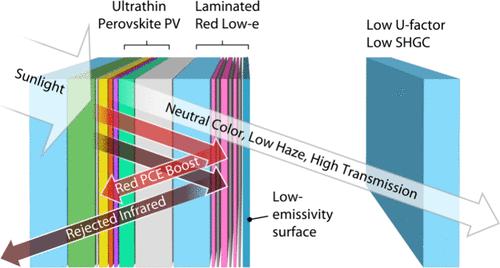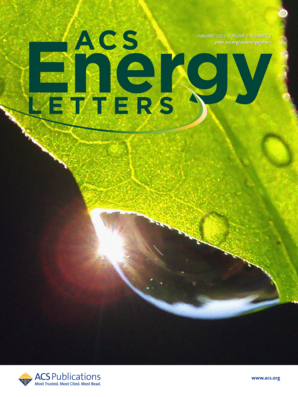Holistic Thermo-Optical Design of Laminate Layers for Halide Perovskite Photovoltaic Windows
IF 19.3
1区 材料科学
Q1 CHEMISTRY, PHYSICAL
引用次数: 0
Abstract
Though power conversion is an important metric for photovoltaic windows, it must be balanced with visible transmittance, aesthetics (color and haze), and thermal performance. Optical properties are often reported, but thermal performance is typically neglected entirely in photovoltaic window design. Here, we introduce the strategy of using laminate layers to improve the thermo-optical performance of perovskite-based photovoltaic insulating glass units. We design the laminates and insulating glass units by coupling a transfer matrix method optical model to a 1D heat transfer model. We validate our models with experimental fabrication of one-dimensional photonic crystal layers that are deposited on glass and laminated to the perovskite photovoltaic device. The holistic designs neutralize the inherent transmissive red color, and the “red low-e” design dramatically reduce emissivity of the glass surface to significantly improve thermal insulation and boost the photocurrent of the device.

卤化物过氧化物光伏窗口层压板的整体热光学设计
虽然功率转换是光伏窗的一项重要指标,但它必须与可见光透射率、美观度(颜色和雾度)以及热性能相平衡。光学性能经常被报道,但热性能通常在光伏窗设计中被完全忽略。在此,我们介绍了使用层压板来改善基于包晶石的光伏中空玻璃单元的热光学性能的策略。我们通过将传递矩阵法光学模型与一维传热模型相结合来设计层压板和中空玻璃单元。我们通过实验制造一维光子晶体层,将其沉积在玻璃上并层压到光伏设备上,从而验证了我们的模型。整体设计中和了固有的透射红色,而 "红色低辐射 "设计则大大降低了玻璃表面的辐射率,从而显著改善了隔热性能并提高了设备的光电流。
本文章由计算机程序翻译,如有差异,请以英文原文为准。
求助全文
约1分钟内获得全文
求助全文
来源期刊

ACS Energy Letters
Energy-Renewable Energy, Sustainability and the Environment
CiteScore
31.20
自引率
5.00%
发文量
469
审稿时长
1 months
期刊介绍:
ACS Energy Letters is a monthly journal that publishes papers reporting new scientific advances in energy research. The journal focuses on topics that are of interest to scientists working in the fundamental and applied sciences. Rapid publication is a central criterion for acceptance, and the journal is known for its quick publication times, with an average of 4-6 weeks from submission to web publication in As Soon As Publishable format.
ACS Energy Letters is ranked as the number one journal in the Web of Science Electrochemistry category. It also ranks within the top 10 journals for Physical Chemistry, Energy & Fuels, and Nanoscience & Nanotechnology.
The journal offers several types of articles, including Letters, Energy Express, Perspectives, Reviews, Editorials, Viewpoints and Energy Focus. Additionally, authors have the option to submit videos that summarize or support the information presented in a Perspective or Review article, which can be highlighted on the journal's website. ACS Energy Letters is abstracted and indexed in Chemical Abstracts Service/SciFinder, EBSCO-summon, PubMed, Web of Science, Scopus and Portico.
 求助内容:
求助内容: 应助结果提醒方式:
应助结果提醒方式:


